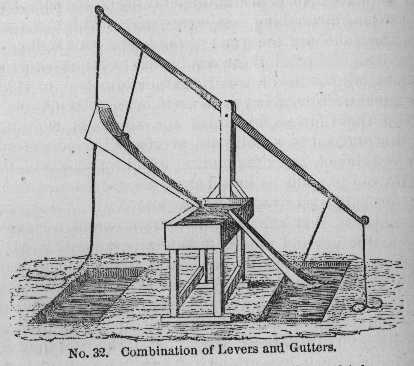
Ewbank, Hydraulics. Fig. 32.
Image public domain.
Rolling Ball Technology
An Online Technical Reference Devoted to
Rolling Ball Sculptures, Clocks, and other Devices
By Members of the rolling-ball@lemur.com List
By David M. MacMillan
Any number of lifting devices are possible which use tilting channels.
Ewbank describes the jantu as follows, but does not illustrate it with a figure:
[Page 89; running head "The Jantu"; text public domain]
THE JANTU
The jantu is a machine extensively used in Bengal and other parts of India, to raise water for the irrigation of land, and is thus described by Mr. Ward, in his History of the Hindoos. "It consists of a hollow trough of wood, about fifteen feet long, six inches wide, and ten inches deep, and is placed on a horizontal beam lying on bamboos fixed in the bank of a pond or river. One end of the trough rests upon the bank, where a gutter is prepared to carry off the water, and the other end is dipped in the water, by a man standing on a stage, plunging it in with his foot. A long bamboo with a large weight of earth at the farther end of it, is fastened to the end of the jantu near the river, and passing over the gallows before mentioned poises up the jantu full of water, and causes it to empty itself into the gutter. This machine raises water three feet, but by placing a series of them one above another, it may be raised to any height, the water being discharged into small reservoirs, sufficiently deep to admit the jantu above, to be plunged low enough to fill it." Mr. Ward observes that the water is thus conveyed over rising ground to the distance of a mile and more. In some parts of Bengal they have different methods of raising water, "but the principle is the same."
There is in this apparently rude machine, a more perfect applicatioin of mechanical science, than would appear to a general observer. As the object of the long bamboo lever is to overcome the weight of the water, it might be asked, why not load the end of the jantu itself, which is next the bank sufficiently for that purpose, and thereby avoid the use of this additional lever, which renders the apparatus more complex, and apparently unnecessarily so? A little reflection will develope [sic] the reasons that led to its introduction, and will at the same time furnish another proof of oriental ingenuity. As the position of the jantu is nearly horizontal when it discharges the water, if the end were loaded as proposed, it would descend on the bank with an increasing velocity; for the weight would be at the end of a lever which virtually lengthened as it approached the horizontal position; and this effect would be still further augmented by the resistance of the water diminishing as the jantu rose, that is, by its flowing towards the centre --- the consequence would be, that the violent concussions, when thus brought in contact with the bank, would speedily shake it to pieces. Now this result is ingeniously avoided by the lever and its weight. Thus, when the laborer has plunged the end of the jantu next him into the water, this lever (as we suppose, for we have not seen a figure of it) is place, so as to be nearly in a horizontal position, by which its maximum force is exerted at the precise time when it is required, i.e. when the jantu is at its lowest position and full of water; and as the latter ascends, the loaded end of the lever descends, and its force diminishing, brings the end of the jantu gradually to rest. A somewhat similar effect might be produced, by making the load on the lever descend into the water, es- [Page 90 begins] pecially if its specific gravity varied but little from that fluid. Traits like this, which are often found in ancient devices, are no mean proofs of skill in the older mechanicians; and as professors of the fine arts, discover the works of masters by certain characteristic touches, and by the general effectof a painting or sculpture --- so professors of the useful arts may point to features like the above, as proofs that they bear the impress of the master mechanics of old.
[Ewbank then goes on to treat of other foot-operated devices in antiquity.]
[Although Ewbank does not illustrate the jantu, in his discussion following it he does illustrate a double version of a similar apparatus powered by overhead ropes rather than the foot. To visualize the jantu, imagine, for instance, the following machine with only the left trough. Place this half-machine at stream level rather than elevated, place a counterweight on the right end of the upper arm, and imagine that it is worked by pushing the trough into the stream with the foot rather than by pulling down on an overhead rope.]

Ewbank, Hydraulics. Fig. 32.
Image public domain.
Jacob Leupold, in his Theatrum Machinarum illustrates:
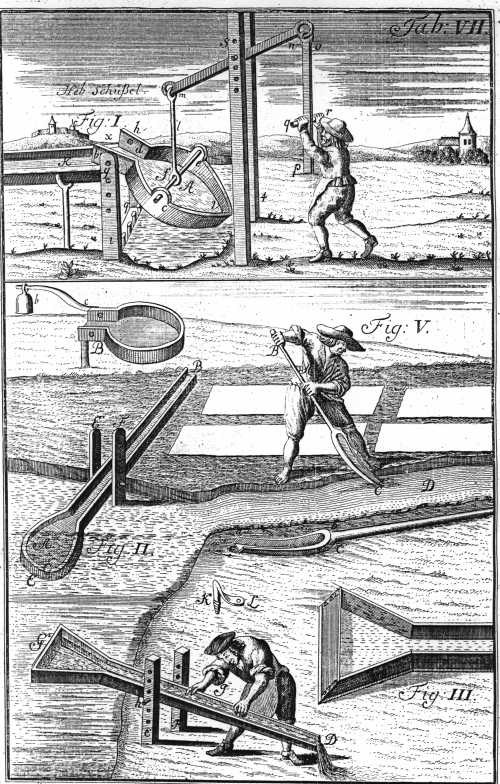
Jacob Leupold.
Theatrum Machinarum.
(Tom. III: Theatrum Machinarum Hydraulicarum, Tom. I.)
Tab. VII.
Image public domain.

Jacob Leupold.
Theatrum Machinarum.
(Tom. III: Theatrum Machinarum Hydraulicarum, Tom. I.)
Tab. VIII, Fig. 1.
Image public domain.
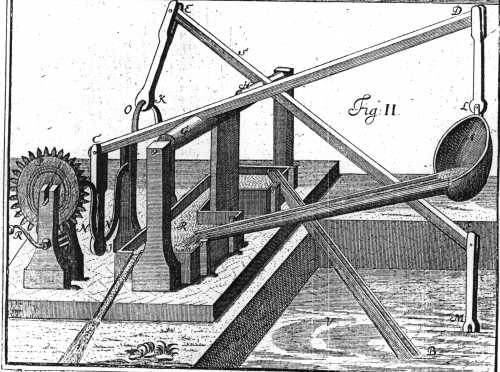
Jacob Leupold.
Theatrum Machinarum.
(Tom. III: Theatrum Machinarum Hydraulicarum, Tom. I.)
Tab. VIII, Fig. 2.
Image public domain.
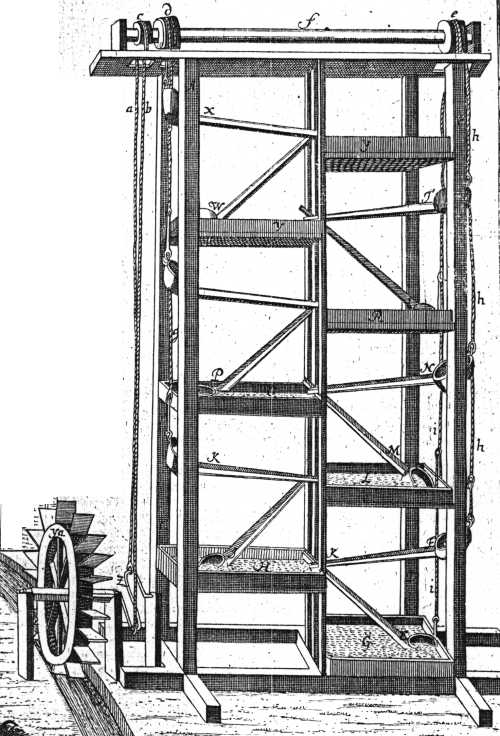
Jacob Leupold.
Theatrum Machinarum.
(Tom. III: Theatrum Machinarum Hydraulicarum, Tom. I.)
Tab. IX, Fig. 1.
Image public domain.
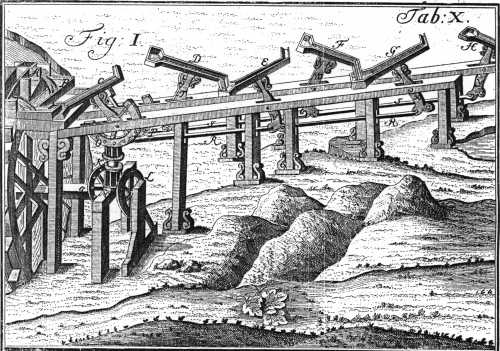
Jacob Leupold.
Theatrum Machinarum.
(Tom. III: Theatrum Machinarum Hydraulicarum, Tom. I.)
Tab. X, Fig. 1.
Image public domain.
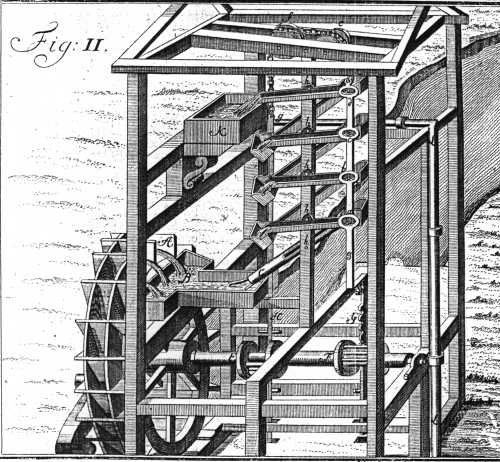
Jacob Leupold.
Theatrum Machinarum.
(Tom. III: Theatrum Machinarum Hydraulicarum, Tom. I.)
Tab. X, Fig. 2.
Image public domain.
With the exception of material noted as being in the public domain, the text, images, and encoding of this document are copyright © 1997-1998 by their author(s) and editor(s): David M. MacMillan.
This document is licensed for private, noncommercial, nonprofit viewing by individuals on the World Wide Web. Any other use or copying, including but not limited to republication in printed or electronic media, modification or the creation of derivative works, and any use for profit, is prohibited.
This writing is distributed in the hope that it will be useful, but "as-is," without any warranty of any kind, expressed or implied; without even the implied warranty of merchantability or fitness for a particular purpose.
In no event will the author(s) or editor(s) of this document be liable to you or to any other party for damages, including any general, special, incidental or consequential damages arising out of your use of or inability to use this document or the information contained in it, even if you have been advised of the possibility of such damages.
In no event will the author(s) or editor(s) of this document be liable to you or to any other party for any injury, death, disfigurement, or other personal damage arising out of your use of or inability to use this document or the information contained in it, even if you have been advised of the possibility of such injury, death, disfigurement, or other personal damage.
All trademarks or registered trademarks used in this document are the properties of their respective owners and (with the possible exception of any marks owned by the author(s) or editor(s) of this document) are used here for purposes of identification only. A trademark catalog page lists the marks known to be used on these web pages. Please e-mail dmm@lemur.com if you believe that the recognition of a trademark has been overlooked.
Version
1.2, 1998/06/20.
Feedback to dmm@lemur.com
http://www.database.com/~lemur/rbt-jantu.html
Go to the: